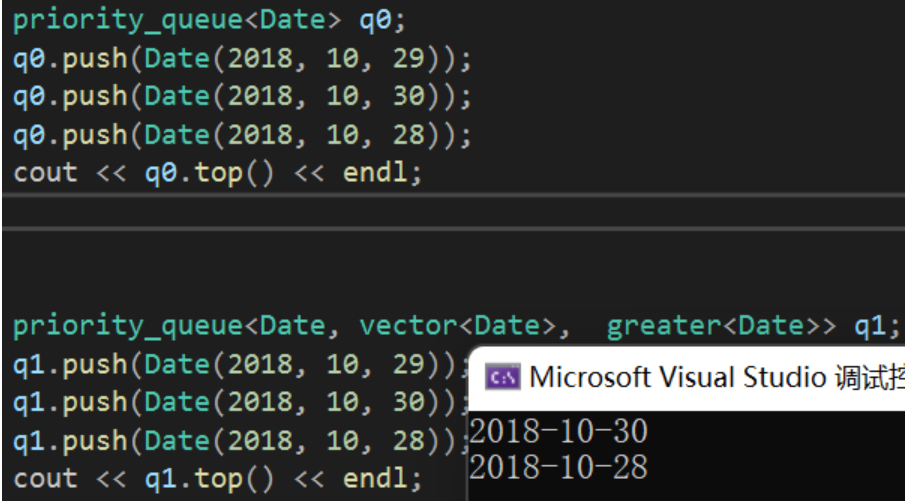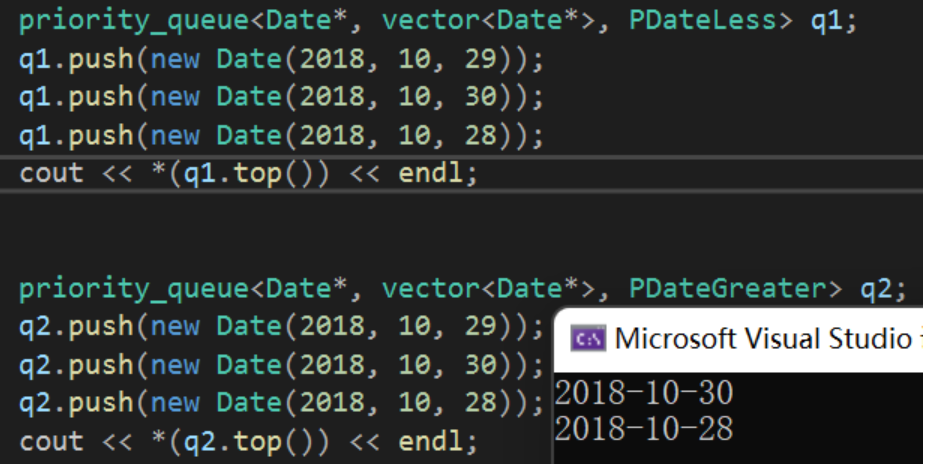文章目录
模拟实现priority_queue
1. priority_queue的介绍
- 优先队列是一种容器适配器,根据严格的弱排序标准,它的第一个元素总是它所包含的元素中最大的。
- 此上下文类似于堆,在堆中可以随时插入元素,并且只能检索最大堆元素(优先队列中位于顶的元素)。
- 优先队列被实现为容器适配器,容器适配器即将特定容器类封装作为其底层容器类,queue提供一组特定的成员函数来访问其元素。元素从特定容器的“尾部”弹出,其称为优先队列的顶部。
- 底层容器可以是任何标准容器类模板,也可以是其他特定设计的容器类。容器应该可以通过随机访问迭代器访问,并支持以下操作:
- empty():检测容器是否为空
- size():返回容器中有效元素个数
- front():返回容器中第一个元素的引用
- push_back():在容器尾部插入元素
- pop_back():删除容器尾部元素
- 标准容器类vector和deque满足这些需求。默认情况下,如果没有为特定的priority_queue类实例化指定容器类,则使用vector。
- 需要支持随机访问迭代器,以便始终在内部保持堆结构。容器适配器通过在需要时自动调用算法函数make_heap、push_heap和pop_heap来自动完成此操作。
2. priority_queue的使用
优先级队列默认使用vector作为其底层存储数据的容器,在vector上又使用了堆算法将vector中元素构造成堆的结构,因此priority_queue就是堆,所有需要用到堆的位置,都可以考虑使用priority_queue 。注意:默认情况priority_queue是大堆。
[注意]
- 默认情况下,priority_queue是大堆。
#include <vector>
#include <queue>
#include <functional> // greater算法的头文件
int main()
{
// 默认情况下,创建的是大堆,其底层按照小于号比较
vector<int> v{
3,2,7,6,0,4,1,9,8,5 };
priority_queue<int> q1;
for (auto& e : v)
q1.push(e);
cout << q1.top() << endl;
// 如果要创建小堆,将第三个模板参数换成greater比较方式
priority_queue<int, vector<int>, greater<int>> q2(v.begin(), v.end());
cout << q2.top() << endl;
}

- 如果在priority_queue中放自定义类型的数据,用户需要在自定义类型中提供> 或者< 的重载。
3. 仿函数
3.1 仿函数的介绍
对于上面的创建成小堆的格式,发现有一个:
greater<int>参数,priority_queue中自带的缺省参数为less,即升序大堆,因此想要建大堆就不需要进行换参数的操作,直接priority_queue<int>就是大堆,上面的结果就是这样,想要换成小堆就得这样:priority_queue<int, vector<int>, greater<int>>通过利用仿函数可以将比较的顺序进行颠倒,通过改变内置的比较符号从而灵活的改变按照大小的排序。
仿函数又叫函数对象,仿函数就是一个类,仿函数的函数对象就是类对象,成员是什么无所谓,下面先看一个简单的例子:
namespace yj
{
template<class T>
class less
{
public://operator()就是一个运算符重载
bool operator()(const T& x, const T& y) const
{
return x < y;
}
};
template<class T>
class greater
{
public:
bool operator()(const T& x, const T& y) const
{
return x > y;
}
};
}
int main()
{
yj::less<int> lessFunc;
lessFunc(1, 2);
//lessFunc.operator()(1, 2);//实际上是这样的展开过程
return 0;
}
即在之前的印象中,通过调用lessFunc,就可以把lessFunc看成一个函数名,但在这里lessFunc是一个函数对象,仿函数的对象,这个对象可以像函数一样去使用,但实际上这个对象不是直接像往常的函数一样直接调用。而是调用了运算符重载,即实际上就是这样: lessFunc.operator()(1, 2);但不会这样去写,因为运算符重载就是为了可读性。
3.2 仿函数的好处
在C语言中qsort的升降序是使用函数指针,传入大于就是大于比较,传入小于就是小于比较。那C++为什么不使用函数指针呢?
候捷老师总结:
为什么函数指针可以达到“将数组操作当做算法的参数”,那又何必有所谓的仿函数呢?函数指针毕竟不能满足STL对抽象性的要求,也不能满足软件积木的要求---->函数指针无法和STL其他组件搭配,产生更灵活的变化。
4. priority_queue的模拟实现
学习了优先级队列中的仿函数的相关知识,就可以模拟实现一个priority_queue了,与上次的stack/queue的模拟实现类似,底层也是适配器实现,没有用到迭代器。
namespace yj
{
template <class T>
struct less //大堆
{
bool operator()(const T& x, const T& y)
{
return x < y;
}
};
template <class T>
struct greater //小堆
{
bool operator()(const T& x, const T& y)
{
return x > y;
}
};
template<class T, class Container = vector<T>, class Compare = less<T>>
class priority_queue
{
public:
void adjust_up(int child)
{
Compare com;
int parent = (child - 1) / 2;
while (child > 0)
{
//if (_con[child] > _con[parent])
//if (Compare()(_con[parent], _con[child])) //匿名对象
if (com(_con[parent], _con[child]))
{
swap(_con[child], _con[parent]);
child = parent;
parent = (child - 1) / 2;
}
else
{
break;
}
}
}
void adjust_down(int parent)
{
Compare com;
int child = parent * 2 + 1;
while (child < _con.size())
{
//找左右孩子中最大的那个
if(child+1<_con.size() && com(_con[child], _con[child + 1]))
++child;
//if (_con[child] > _con[parent])
if (com(_con[parent], _con[child]))
{
swap(_con[child], _con[parent]);
parent=child;
child = parent * 2 + 1;
}
else
{
break;
}
}
}
void push(const T& x) //插入元素 + 向上调整
{
_con.push_back(x);
adjust_up(_con.size() - 1);
}
void pop() //删除元素(交换堆顶元素和堆尾元素,后删除) + 向下调整
{
swap(_con[0], _con[_con.size() - 1]);
_con.pop_back();
adjust_down(0);
}
T& top()
{
return _con[0];
}
size_t size()
{
return _con.size();
}
bool empty()
{
return _con.empty();
}
private:
Container _con;
};
}
5. 用仿函数实现日期比较
日期类的比较用仿函数:
namespace yj:
{
template <class T>
struct less //大堆
{
bool operator()(const T& x, const T& y)
{
return x < y;
}
};
template <class T>
struct greater //小堆
{
bool operator()(const T& x, const T& y)
{
return x > y;
}
};
class Date
{
public:
Date(int year = 1900, int month = 1, int day = 1)
: _year(year)
, _month(month)
, _day(day)
{
}
bool operator<(const Date& d)const
{
return (_year < d._year) ||
(_year == d._year && _month < d._month) ||
(_year == d._year && _month == d._month && _day < d._day);
}
bool operator>(const Date& d)const
{
return (_year > d._year) ||
(_year == d._year && _month > d._month) ||
(_year == d._year && _month == d._month && _day > d._day);
}
friend ostream& operator<<(ostream& _cout, const Date& d)
{
_cout << d._year << "-" << d._month << "-" << d._day;
return _cout;
}
private:
int _year;
int _month;
int _day;
};
void test2()
{
priority_queue<Date> q0;
q0.push(Date(2018, 10, 29));
q0.push(Date(2018, 10, 30));
q0.push(Date(2018, 10, 28));
cout << q0.top() << endl;
priority_queue<Date, vector<Date>, greater<Date>> q1;
q1.push(Date(2018, 10, 29));
q1.push(Date(2018, 10, 30));
q1.push(Date(2018, 10, 28));
cout << q1.top() << endl;
}
}

如果是Date*,就需要自己再去写一个仿函数:即地址解引用的仿函数。
namespace yj:
{
class Date
{
public:
Date(int year = 1900, int month = 1, int day = 1)
: _year(year)
, _month(month)
, _day(day)
{
}
bool operator<(const Date& d)const
{
return (_year < d._year) ||
(_year == d._year && _month < d._month) ||
(_year == d._year && _month == d._month && _day < d._day);
}
bool operator>(const Date& d)const
{
return (_year > d._year) ||
(_year == d._year && _month > d._month) ||
(_year == d._year && _month == d._month && _day > d._day);
}
friend ostream& operator<<(ostream& _cout, const Date& d)
{
_cout << d._year << "-" << d._month << "-" << d._day;
return _cout;
}
private:
int _year;
int _month;
int _day;
};
class PDateLess //大堆
{
public:
bool operator()(const Date* p1, const Date* p2)
{
return *p1 < *p2;
}
};
class PDateGreater //小堆
{
public:
bool operator()(const Date* p1, const Date* p2)
{
return *p1 > *p2;
}
};
void test2()
{
priority_queue<Date*, vector<Date*>, PDateLess> q1;
q1.push(new Date(2018, 10, 29));
q1.push(new Date(2018, 10, 30));
q1.push(new Date(2018, 10, 28));
cout << *(q1.top()) << endl;
priority_queue<Date*, vector<Date*>, PDateGreater> q2;
q2.push(new Date(2018, 10, 29));
q2.push(new Date(2018, 10, 30));
q2.push(new Date(2018, 10, 28));
cout << *(q2.top()) << endl;
}
}
